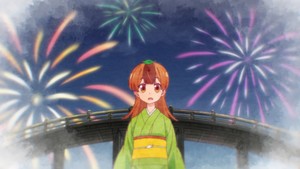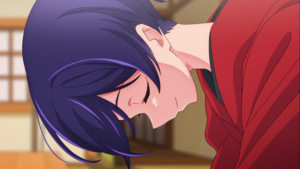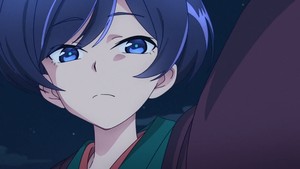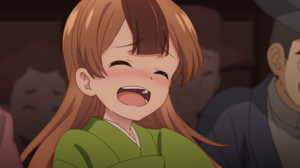The Fall 2022 Preview Guide
My Master Has No Tail
How would you rate episode 1 of
My Master Has No Tail ?
Community score: 3.5
What is this?

In Japan's Taishō era (1912–1926), Mameda is a shape-shifting tanuki girl who dreams of becoming human. Mameda transforms her outward appearance into a pretty raven-haired human girl and heads to the bustling city of Osaka. However, people instantly see through Mameda's guise, and one beautiful woman ruthlessly says to the dejected Mameda, "Go back where you came from." As it turns out, that woman named Bunko is herself a supernatural creature who transformed herself into a rakugo (comic storytelling) storyteller. Mameda begs Bunko to become her master and teach her the ways of playing a human.
My Master Has No Tail is based on TNSK's manga and streams on HIDIVE on Fridays.
How was the first episode?
 Rebecca Silverman
Rebecca Silverman
Rating:
My Master Has No Tail takes a different angle on the supernatural story: what if, with the advancing times and the rise of technology, folkloric tricksters can no longer ply their traditional trade? If the story was set in the Reiwa era with the internet the answer might be different, but for Mameda, a young tanuki in the Taisho period, things are looking pretty grim. Not only have electric lights (and presumably gaslights) made sneaking up on people on dark streets near impossible, but the general human population just isn't as gullible as they used to be, and with their fancy watermarked money, it's gotten so that a girl can't even run a supernatural scam anymore. Since Mameda desperately wants to follow in her forefathers' footsteps, that's not great news.
But luckily for her, the world never gets tired of stories. While the method of delivery Mameda discovers is specifically rakugo, the idea she's enraptured with is something that's pretty universal: people want to be fooled for their own entertainment. She could just have easily gotten into silent films or any other period-appropriate form, but rakugo seems to speak to her traditional soul: reliant on wordplay and exaggerated gestures and done from a proper sitting position, rakugo is the closest thing to playing tricks that Mameda can understand. And it is a captivating art form; I was lucky enough to see a performance by a French rakugoka (trained in Japan) at a con in France, and it really does pull you in with its practiced gestures, use of voices, and minimal movements. Yes, the same could be said for any good storyteller, but the careful parameters of rakugo make it feel particularly special.
Of course, Mameda has to get her prospective master to agree to train her, and even then she may have some difficulties relying on her storytelling powers rather than her tanuki tricks. But there's room to blend the two aspects, and I have never been so glad that I feel so far behind on a manga, because now I can just go inhale the series when Preview Guide is over. While the actual rakugo performance in the episode does drag on a little (the wordplay's not as easy to follow in the subs), I love the framing of the show as a performance by the rakugoka and the way that the story blends the supernatural with modern progress, as well as the contrast between the cartoonish animal forms and the human ones. There's something wonderful about being told a story, and I'm looking forward to seeing how this one plays out.
 Nicholas Dupree
Nicholas Dupree
Rating:
I don't want to dump on this show too hard, because it's not bad, per se. It's more that it's just middling at damn near everything it does, and exists at an intersection of storytelling elements that I've seen done better, separately, in different places. I'm certainly no expert in Rakugo, but I've seen enough media centered around it to recognize the gap between how this premiere handles the topic vs Shōwa Genroku Rakugo Shinjū or Akane-banashi. Meanwhile its portrayal of yokai, and transforming tanuki in particular, just feels so barebones that it's hard to get much out of it besides some cute mascot characters and a single funny joke on the old bit about raccoon-dog scrotums. These ideas aren't bad or inherently incompatible, but neither element feels sharp enough to hook you in, especially not with the languid energy of this premiere.
A big issue is also the art and animation of it all. Rakugo is, ironically, a really difficult thing to animate because of its minimalism. A skilled Rakugoka communicates their stories not just through words and pantomime, but subtle facial tics, body language, and a million other tiny elements of human communication that take a lot of time and attention to properly capture through a drawing. Rakugo Shinju had to basically dedicate all of its visual storytelling to approximate it, and frankly the simplistic art style here just isn't up to snuff. Doesn't help that the premiere's visual shorthand for storytime is to slap a hazy filter over otherwise identical animation. So instead of being transported to a new fictional subreality where the story and characters come to life before our eyes, we're transported to a world where somebody slathered vaseline on our laptop screen and we have to keep wiping it off. It's just too lax and simple to capture the charm of the art form or the stories it tells, and that kneecaps the whole endeavor.
Then there's the actual characters, who are...fine. We only meet our heroine Mameda and her soon-to-be-master Bunko, and while they serve their roles in the story perfectly well, neither leave much of an impression. There are hints of interesting ideas here, like Mameda viewing the imagination-driving power of rakugo as a “trick” the same as her transformations or illusions, but when neither of those feels particularly magical it's hard to get invested. Similarly, the conflict of human industrialization weeding out the supernatural from human society is a solid one, but it's not really fleshed out enough here beyond a very dull wistfulness. They're not total ciphers, but neither are they interesting enough as-is to make you want to follow them.
Like I said, this isn't a bad premiere, but it's not really a good one either. Simple ideas delivered with underwhelming presentation just doesn't make for a compelling watch, so unless you need something extremely stakes-less to relax to, I can't really recommend it.
 Richard Eisenbeis
Richard Eisenbeis
Rating:
I like the ideas explored in this first episode of My Master Has No Tail far more than the episode itself. This episode takes Arthur C. Clarke's third law, “any sufficiently advanced technology is indistinguishable from magic,” in a cool, new direction. We all fear the unknown. The supernatural—i.e., magic—is one such unknown. Tanukis have been able to play on this fear with their tricks throughout human history, but My Master Has No Tail posits that, if technological development surpasses magic, magic loses its mystery and is no longer something to be feared. It's no longer “magical.”
But further still, the anime suggests that human nature needs the supernatural—that it longs to experience something beyond the grounded, everyday life that technology provides. And so when magic can no longer captivate the human soul, humans will find new magic elsewhere—i.e., in the fictional worlds of stories. That is some solid insight into what makes us human and using the traditional Japanese storytelling art of rakugo as the medium to explore this concept is likewise inspired—well, at least in theory anyway.
My big problem with this episode is that the rakugo performance isn't just sub-par, it's downright terrible. Maybe I'm a rakugo snob but Bunko's performance completely shattered my suspension of disbelief. Shape-shifting tanukis? Fine. Boats flying through the skies? No problem. The idea that a rakugo storyteller this bad would be famous enough to draw a packed house? Completely insane.
The fact that the episode has to spend its last two minutes explaining the plot and the jokes in the rakugo scene we just watched minutes before is also a major issue. If your audience can't understand the rakugo story as they're watching it, either your way of portraying the story is flawed or you chose the wrong story to tell—or both in the case of My Master Has No Tail. Despite my love for rakugo (or perhaps because of it), one episode of this was enough for me. I won't be coming back for more next week.
 Caitlin Moore
Caitlin Moore
Rating:
Perhaps it is unfair to My Master Has No Tail that it is currently being judged by one of the approximately dozen anime fans in the US who watched and adored both Shōwa Genroku Rakugo Shinjū and The Eccentric Family. Every moment I spent watching Mameda fumble around cutely trying to trick modern humans, every line the rakugoka spoke, reminded me of how incredible those two shows are, and how underappreciated they are. I also felt like I would really, really prefer to be watching either one of them instead of this one.
My Master Has No Tail takes a similar setting – the world of rakugo – and similar themes – creatures of folklore finding their place in an increasingly modernized Japan – and just doesn't do it as well as either one. Instead of masterful, it's… fine? Cute, even. The visual style is distinctive and appealing, and the backgrounds kind of remind me of an ukiyo-e print meets a picture book. There's some neat shots simulating multiplanar camerawork as well. It can even be beautiful at times.
However, the pacing and storytelling are a bit lacking. The episode's big centerpiece, the rakugo story that Mameda happens to see, flopped hard. Hibiku Yamamura just doesn't have the vocal chops or flexibility to pull off multiple characters, relying entirely on using feminine vs masculine vs childish speech patterns instead of modulating her voice, varying her inflection, building character through physicality, and so on. This doesn't translate in the subtitles, since English doesn't work that way, so it's nearly impossible to tell who is supposed to be speaking. Without being able to distinguish the characters, the story drags, and the episode more or less falls apart, and I start thinking about Akira Ishida's tour-de-force performance as Kikuhiko in Rakugo Shinju instead.
There is a nice balance, though, in the episode's recognition of the value in both tradition and modernity. It would be too easy to settle into the characters longing for the old times, grumbling about how life these days moves too fast and nobody has time to stop and appreciate the old ways anymore. Instead, even as the characters reflect on their role as tricksters in an increasingly skeptical modern world, they also appreciate the beauty of progress. Rakugo, like any performing art, is another way of weaving illusions, after all, and even if humans don't fall for the old wheel of fire anymore, they still want to be drawn into a fantasy as much as they ever have.
But then again, the intersection of modernity and tradition by way of tanuki was already done better in The Eccentric Family. Is this unfair? Probably. But also, I want to encourage as many people as I can to watch these two criminally underwatched series. My Master Has No Tail isn't anything special, but they are.
discuss this in the forum (316 posts) |
back to The Fall 2022 Preview Guide
Season Preview Guide homepage / archives